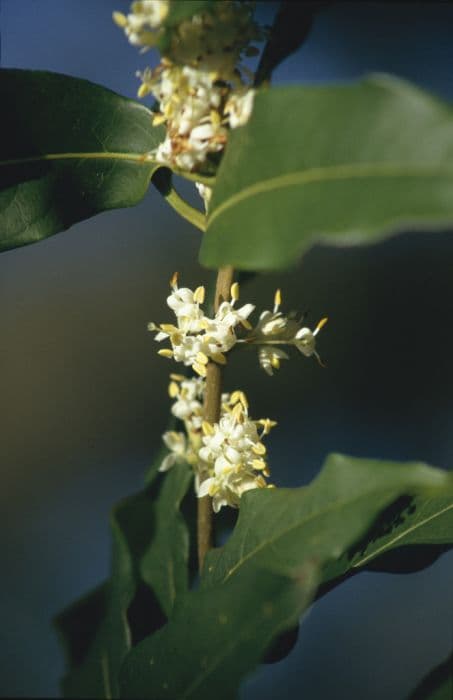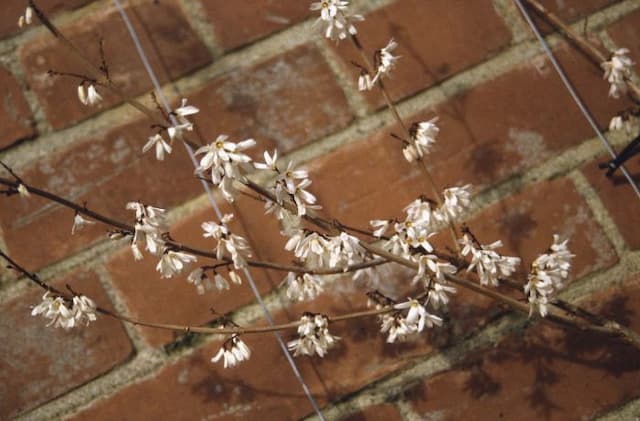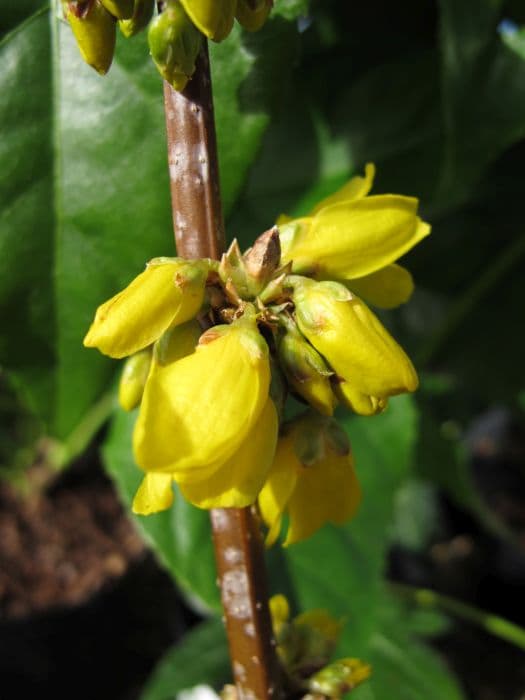Yunnan Osmanthus Osmanthus yunnanensis

ABOUT
Osmanthus yunnanensis, commonly known as the Yunnan osmanthus, is a plant notable for its striking features. The Yunnan osmanthus typically has a dense, rounded form, and its branches bear a wealth of leathery, dark green leaves. These leaves tend to be long and somewhat narrow, with a subtly serrated margin giving them a textured appearance along the edges. The plant is cherished for its beautiful clusters of small, tubular flowers that blossom into creamy white tones. These flowers often exhibit a delightful fragrance reminiscent of ripe peaches or apricots, adding sensory appeal to gardens and landscapes. After the flowering period, the Yunnan osmanthus may produce small, blue-black fruits that add an additional layer of visual interest to the plant. The overall appearance of Yunnan osmanthus is elegant, and it's appreciated for the refined aesthetic it can bring to a space. Its foliage can add lushness and a sense of fullness to garden designs, making it an attractive choice for ornamental purposes.
About this plant
 Names
NamesFamily
Oleaceae
Synonyms
Yunnan Osmanthus, Yunnan Sweet Olive
Common names
Osmanthus yunnanensis.
 Toxicity
ToxicityTo humans
Osmanthus yunnanensis, commonly known as Yunnan Osmanthus, is not widely reported as a toxic plant to humans. There is limited information regarding its toxicity and possible consequences of ingestion. Therefore, if you suspect poisoning from any plant, including Yunnan Osmanthus, it is crucial to seek professional medical advice promptly.
To pets
There is limited specific information regarding the toxicity of Yunnan Osmanthus (Osmanthus yunnanensis) to pets. Osmanthus in general is not commonly listed among plants that are toxic to pets. However, because individual pets may have different sensitivities or allergies, and because the complete toxicity profile of this specific species may not be well documented, it is always best to prevent pets from ingesting plants and to consult a veterinarian if any unusual symptoms appear after ingestion.
 Characteristics
CharacteristicsLife cycle
Perennials
Foliage type
Evergreen
Color of leaves
Green
Flower color
White
Height
10 feet (3 meters)
Spread
6 feet (1.8 meters)
Plant type
Shrub
Hardiness zones
7
Native area
China
Benefits
 General Benefits
General Benefits- Aesthetic appeal: Osmanthus yunnanensis, commonly known as Yunnan osmanthus, offers ornamental value with its attractive foliage and fragrant flowers that can enhance garden landscapes.
- Habitat for wildlife: The plant provides a habitat and food source for various species of bees, birds, and other pollinators, which are attracted to its blooms.
- Fragrance: Yunnan osmanthus is well-known for its sweet and pleasant aroma, which can be enjoyed in gardens or when used in floral arrangements.
- Drought resistance: Once established, this plant is relatively drought-tolerant, making it suitable for gardens in dryer climates or for gardeners seeking low-maintenance landscaping options.
- Hedging and screening: With its dense growth habit, Yunnan osmanthus can be used as a hedge or screen, providing privacy and reducing noise pollution.
 Medical Properties
Medical PropertiesThis plant is not used for medical purposes.
 Air-purifying Qualities
Air-purifying QualitiesThis plant is not specifically known for air purifying qualities.
 Other Uses
Other Uses- Perfumery: The sweet fragrance of Osmanthus fragrance is used in perfumes, providing a unique floral note.
- Aromatic Oil: Oil extracted from the flowers of Osmanthus fragrance can be used in aromatherapy for its calming properties.
- Flavoring Agent: The blossoms are sometimes used to flavor teas and desserts, giving them a delicate fruity taste.
- Landscape Ornamentation: Due to its attractive foliage and flowers, it is used as an ornamental plant in gardens and parks.
- Bonsai: Osmanthus fragrance is a popular choice for creating bonsai trees because of its manageable size and beautiful appearance.
- Insect Repellant: The foliage of Osmanthus fragrance can be used in potpourris or sachets to naturally ward off moths and other insects.
- Culinary Garnish: Edible osmanthus flowers are sometimes used to garnish dishes, adding a touch of elegance and a mild flavor.
- Floral Displays: Fresh or dried Osmanthus flowers are used in creating decorative floral arrangements and bouquets.
- Cultural Symbolism: In some cultures, Osmanthus fragrance represents good luck and is used in festive decorations.
- Traditional Ceremonies: Osmanthus fragrance is sometimes incorporated into traditional ceremonies and celebrations as a symbol of peace and harmony.
Interesting Facts
 Feng Shui
Feng ShuiThe plant_name is not used in Feng Shui practice.
 Zodiac Sign Compitability
Zodiac Sign CompitabilityThe plant_name is not used in astrology practice.
 Plant Symbolism
Plant Symbolism- Peace and Positivity: Osmanthus yunnanensis, commonly known as Yunnan Osmanthus, often symbolizes peace and positivity due to its soothing fragrance that is thought to calm the mind and elevate moods.
- Nobility: In certain cultures, the sweet scent of the Yunnan Osmanthus is associated with nobility and high status, representing elegance and dignity.
- Good Fortune: The plant is sometimes given as a gift to wish someone good fortune and prosperity, particularly in East Asian cultures.
- Love and Romance: The intoxicating aroma of the Yunnan Osmanthus blooms can signify love and romance, making it a subtle token of affection.
- Beauty: With its delicate flowers and pleasant scent, Yunnan Osmanthus is often associated with beauty and the appreciation of beautiful things in life.
 Water
WaterThe Yunnan Osmanthus should be watered deeply once a week, allowing the soil to become slightly dry between waterings. Use about one to two gallons of water per watering session for younger plants, increasing the amount as the plant matures and depending on the size and root system. Overwatering can lead to root rot, so ensure the plant is in well-draining soil. During periods of high heat and dry weather, you may need to water more frequently, but always check the soil moisture first. In winter, reduce watering to when the soil is dry to the touch, as the plant's water requirements diminish in cooler temperatures.
 Light
LightYunnan Osmanthus thrives in partial to full sunlight, but it should be protected from harsh, direct afternoon sun that can cause leaf burn. The ideal location provides morning sunlight with dappled or filtered shade in the afternoon. This plant is adaptable to a range of lighting conditions, but will flower more abundantly when it receives adequate light.
 Temperature
TemperatureYunnan Osmanthus prefers temperatures ranging from 60°F to 80°F for ideal growth. It is hardy to about 10°F, but prolonged exposure to temperatures below this may damage the plant. Ideal growth occurs within the mentioned temperature range, but brief cold spells are usually tolerated if the plant is well-established.
 Pruning
PruningPrune Yunnan Osmanthus to maintain its shape and encourage bushier growth. The best time for pruning is immediately after the blooming period in early to mid-summer. Remove dead or damaged branches and thin out overgrown areas to allow light into the center of the plant. Pruning can be done annually, but heavy pruning should only be performed every few years to maintain the natural shape of the shrub.
 Cleaning
CleaningAs needed
 Soil
SoilThe Yunnan Osmanthus thrives in well-draining, fertile soil with a pH range of 5.5 to 6.5. Optimal soil mix can be created by blending loam, peat, and sharp sand in equal parts to promote good drainage while retaining adequate moisture and nutrients.
 Repotting
RepottingYunnan Osmanthus should be repotted every 2 to 3 years, or when it becomes root-bound. Spring is the best time to repot this plant to allow the roots to establish in the new pot before the growing season.
 Humidity & Misting
Humidity & MistingThe Yunnan Osmanthus prefers moderate to high humidity levels, ideally between 50% and 60%. Consistent humidity is important for the plant's health but it can tolerate short periods of lower humidity.
 Suitable locations
Suitable locationsIndoor
Ensure bright, indirect light, and maintain humidity for Yunnan Osmanthus.
Outdoor
Place in partial shade, protect from harsh winds for Yunnan Osmanthus.
Hardiness zone
7-9 USDA
 Life cycle
Life cycleThe life of Yunnan Osmanthus begins with seed germination which occurs in a suitable environment of warm temperatures and moist soil. After germination, the seedling emerges and begins to establish a root system and grow its first few leaves in the juvenile phase, which can take several years. As the plant matures into the vegetative stage, it develops a woody stem and a more extensive root system, along with branching and foliage growth. When reaching maturity after several years, Yunnan Osmanthus enters the reproductive phase, producing fragrant flowers that are typically white or yellow, attracting pollinators for sexual reproduction. Following pollination, the flowers develop into fruits; these fruits contain seeds which, when dispersed, have the potential to grow into new plants if they land in favorable conditions. Finally, once it reaches the end of its lifespan which can be several decades, the plant will die, completing its life cycle.
 Propogation
PropogationPropogation time
Spring to summer
For propagating the Osmanthus yunnanensis, also known as Yunnan Osmanthus, the most popular method is via semi-hardwood cuttings. This is typically done in the late summer months when the plant's new growth has partially matured yet still retains some flexibility. To do this, a cutting of about 4 to 6 inches (10 to 15 centimeters) long is taken from a healthy part of the plant. The lower leaves are removed and the cut end is dipped into a rooting hormone to encourage root development. The cutting is then planted in a pot filled with a mixture of peat and perlite, ensuring the environment is kept humid and that the cutting receives gentle, indirect sunlight. The medium should be kept consistently moist but not overly wet to prevent rot. With proper care, roots will begin to form in a few weeks, after which the new Yunnan Osmanthus can eventually be transplanted into the garden.









